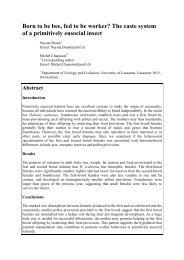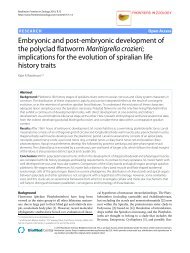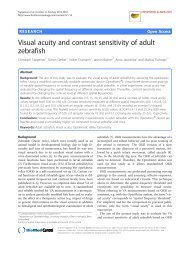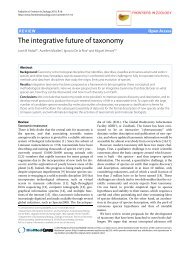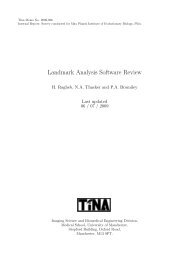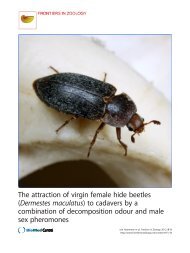Provisional PDF - Frontiers in Zoology
Provisional PDF - Frontiers in Zoology
Provisional PDF - Frontiers in Zoology
Create successful ePaper yourself
Turn your PDF publications into a flip-book with our unique Google optimized e-Paper software.
Menzel et al. <strong>Frontiers</strong> <strong>in</strong> <strong>Zoology</strong> 2013, 10:32 Page 4 of 12<br />
http://www.frontiers<strong>in</strong>zoology.com/content/10/1/32<br />
measured whether the Ca. rufifemur aggression differed between<br />
<strong>in</strong>tracolonial and allocolonial Cr. modiglianii. In<br />
three subsequent treatments, we similarly determ<strong>in</strong>ed<br />
whether Ca. rufifemur dist<strong>in</strong>guished their partner from the<br />
non-nestmate colony, but the Ca. rufifemur ants were only<br />
confronted with cues, presented on odourless ‘dummies’<br />
(dead, solvent-washed ants). These cues were (1) whole cuticular<br />
extracts, (2) cuticular hydrocarbons only, and (3)<br />
crematoenones only, each time from <strong>in</strong>tra- and allocolonial<br />
Cr. modiglianii. The cuticular hydrocarbons of different Cr.<br />
modiglianii colonies show only quantitative differences;<br />
however, those colonies liv<strong>in</strong>g together with the red Ca.<br />
rufifemur variety possess two hydrocarbons that are absent<br />
from those liv<strong>in</strong>g with the black variety [13].<br />
Camponotus rufifemur did not differentiate between<br />
dead <strong>in</strong>tracolonial and dead allocolonial Cr. modiglianii<br />
workers. However, they discrim<strong>in</strong>ated between their<br />
extracts and especially between their hydrocarbon fractions.<br />
Cuticular extracts of allocolonial Cr. modiglianii<br />
elicited significantly more aggression than <strong>in</strong>tracolonial<br />
ones. The hydrocarbon fractions of allocolonial Cr.<br />
modiglianii (R1, liv<strong>in</strong>g with the red Ca. rufifemur variety)<br />
triggered very high aggression, while hydrocarbon fractions<br />
of <strong>in</strong>tracolonial Cr. modiglianii were treated amicably<br />
(Figure 3a). This differential aggression was highly significant.<br />
In contrast, the behaviour towards the crematoenone<br />
fractions was ma<strong>in</strong>ly peaceful for both <strong>in</strong>tracolonial and<br />
allocolonial cues. Similarly, a re-mixture of hydrocarbon<br />
and crematoenone fractions of allocolonial Cr. modiglianii<br />
received little aggression, which corresponds to the weaker<br />
differentiation between the two total extracts compared to<br />
the two hydrocarbon fractions.<br />
A black Ca. rufifemur worker colony from a different<br />
parabiosis (B3) showed comparable behaviour, significantly<br />
differentiat<strong>in</strong>g between hydrocarbon fractions of <strong>in</strong>tra- and<br />
allocolonial Cr. modiglianii but not between their total<br />
extracts or their crematoenone fractions (Figure 3b). In<br />
contrast to the two black Ca. rufifemur colonies (B1 and<br />
B3), however, a red Ca. rufifemur colony (R1) never showed<br />
higher aggression towards allocolonial Cr. modiglianii treatments.<br />
The red Ca. rufifemur workers were confronted<br />
with dead workers, total extracts, hydrocarbons, and<br />
crematoenones of one non-nestmate Cr. modiglianii colony,<br />
and with dead workers and hydrocarbons of two further<br />
non-nestmate Cr. modiglianii colonies. In no case did<br />
the red Ca. rufifemur workers show significant differentiation<br />
from the <strong>in</strong>tracolonial Cr. modiglianii (Figure 3c).<br />
The addition of allocolonial Cr. modiglianii crematoenones<br />
to different extracts significantly reduced aggressiveness<br />
of Ca. rufifemur workers. They strongly attacked dead<br />
bodies of Crematogaster coriaria and Cr. difformis,<br />
as well as their cuticular hydrocarbons and those of<br />
allocolonial Cr. modiglianii. However,Ca. rufifemur was<br />
significantly less aggressive to each of these treatments after<br />
addition of allocolonial Cr. modiglianii crematoenones<br />
(Figure 4, Additional file 1: Table S2). The effect was significantly<br />
higher for Cr. modiglianii extracts than for the<br />
other two species (significant <strong>in</strong>teraction ‘Crematogaster<br />
species’: ‘crematoenone addition’, Additional file 1: Table S2),<br />
but still show a trend when only Cr. coriaria and Cr.<br />
difformis were considered (GLM with Cr. coriaria and Cr.<br />
difformis only: F 1,39 =2.9,P =0.09).<br />
Behavioural assays: Crematogaster towards Camponotus<br />
In a similar test series, we confronted a Crematogaster<br />
modiglianii (colony R0, liv<strong>in</strong>g with a red Ca. rufifemur)<br />
with <strong>in</strong>tra- and allocolonial Ca. rufifemur treatments.<br />
The workers attacked allocolonial dead workers of Ca.<br />
rufifemur significantly more than <strong>in</strong>tracolonial ones. A<br />
similar, significant differentiation was found for whole<br />
cuticular extracts, and also for their hydrocarbon fractions.<br />
Here, aggression aga<strong>in</strong>st black Ca. rufifemur treatments<br />
was much higher than aga<strong>in</strong>st those of red Ca.<br />
rufifemur (Figure 5). In contrast, the crematoenone<br />
fractions did not trigger any significant differentiation<br />
between <strong>in</strong>tra- and allocolonial treatments. In the test series<br />
for both Cr. modiglianii and Ca. rufifemur, all <strong>in</strong>tracolonial<br />
treatments elicited aggression levels comparable to or lower<br />
than hexane controls (Figures 3, 4 and 5).<br />
Discussion<br />
A novel substance class produced by Crematogaster<br />
The cuticle of <strong>in</strong>sects is usually covered with non-polar<br />
hydrocarbons [16]. Only few <strong>in</strong>sects possess oxygenated<br />
hydrocarbon derivatives, and most of these are species<br />
other than ants [17]. Cuticular substances that are neither<br />
hydrocarbons nor hydrocarbon derivatives are<br />
highly unusual <strong>in</strong> <strong>in</strong>sects (but see [14,15]). The parabiotic<br />
ant Crematogaster modiglianii possesses a whole set<br />
of <strong>in</strong>terrelated compounds on its cuticle. In our previous<br />
study, we could show that these substances are likely to<br />
be produced <strong>in</strong> the Dufour’s gland and from there<br />
spread onto the whole cuticle [10].<br />
We characterized the molecular structure of the novel<br />
compounds us<strong>in</strong>g EI-MS, CI-MS, HRMS and NMR.<br />
Searches <strong>in</strong> the CAS database based on similarity or substructure<br />
motifs of compound 10 revealed that this class<br />
of chemicals has not been described for <strong>in</strong>sects nor have<br />
they, to the best of our knowledge, been described <strong>in</strong><br />
nature at all. Based on compound 10, we suggest to<br />
name this substance class ‘crematoenones’, reflect<strong>in</strong>g the<br />
source genus Crematogaster, the double bond <strong>in</strong> the<br />
octahydronaphthalene subunit, and the keto function.<br />
Possible biosynthesis of the crematoenones<br />
The genus Crematogaster is known for its ability to<br />
produce a wide array of structurally diverse chemicals.<br />
[10,18-23]. Compared to other ant species, the




